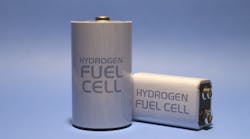Experiments by SLAC and Stanford researchers show that strontium atoms (green spheres) leave the top layer through a corrosion process during the catalystâs first two hours of driving OEM. (Courtesy of Dickens/Stanford University)Scientists at Stanford and the Department of Energy's SLAC National Accelerator Lab reveal a new catalyst that can be used to drive faster oxygen-evolution reactions (OER) in fuel cells and other light-driven renewable energy sources. The catalyst is highlighted for its low levels of iridium—one of the rarest metals on Earth, along with its ability to drive OER at rates 100 times faster than IrOx and ruthenium oxide (RuOx) systems commonly used in acidic fuel-cell environments. Results from the experiment were published in the journal Science.
Using a catalyst database called SUNCAT, the team simulated various catalysts' behavior when deriving diatomic oxygen from water in the presence of light. A partnership between SLAC and Stanford, databases like SUNCAT enable scientists to tweak the structure and molecular constituents of a catalyst to figure out which ones will achieve the desired reaction rates. Various student and research groups add catalyst simulations to the SUNCAT database on a regular basis.
After running tests with SUNCAT, SLAC Staff Scientist Yasuyuki Hikita and SLAC/Stanford Professor Harold Hwang chose to test the behavior of a strontium iridium oxide catalyst in the lab. They placed the catalyst on the surface of an undisclosed material and immersed in an acidic fluid used in fuel cells to measure its ability to drive OER.
The Results
The strontium iridium oxide catalyst worked better than expected due to a corrosion process at the surface of a material. "Surfaces can be very dynamic," says Thomas Jaramillo, an associate professor at SLAC and Stanford and deputy director of the SUNCAT Center for Interface Science and Catalysis. "But in this case the catalyst changes in a way that gives you excellent performance in acid. This is unusual, because under these conditions most materials are either poor catalysts or they completely fall apart."
Over the first two hours, the speed of OER increased exponentially as a corrosion process stripped strontium atoms from the catalyst and left IrO at the surface. In the end, the film of iridium oxide was just a few atomic layers thick, but much more active than the original material.
But the scientists are still unclear as to how the IrO molecules arrange themselves to improve the OER rate after corrosion. To further understand the surface reaction, the team will observe the catalyst with X-ray beams at SLAC's Stanford Synchrotron Radiation Lightsource, a DOE Office of Science User Facility. This will enable them to observe the reaction up close.
"To make a commercially viable catalyst we will need to reduce the amount of iridium in the material even more," said Jens Nørskov, director of SUNCAT and a professor at SLAC and Stanford. "But there are many possibilities, and this gives us some very good leads."

